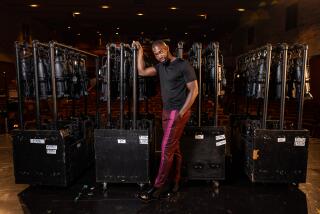Weill’s ‘Happy End’ Gets Fresh Start
- Share via
Sure, a centennial is a natural time for new productions of major work from important artists such as Kurt Weill. The question is, why “Happy End”?
“The songs,” Weba Garretson says flatly. “It has all the great songs.” As Salvation Army missionary Lillian Holiday, Garretson gets to sing many of those songs--including “Surabaya Johnny” and “Bilbao Song”--in a new production of the show opening Wednesday at the Museum of Contemporary Art.
Weill and Bertolt Brecht created “Happy End” in 1929 to follow up on the extraordinary success of their “The Threepenny Opera.” The new piece, ostensibly set in Chicago, is a darkly comic tale of romance between Lillian and a mob gangster, similar to the 1950 musical “Guys and Dolls.” The style and spirit of “Happy End,” however, were highly influenced by 1920s gangster films that Weill and Brecht had seen.
“This is very much about Hollywood,” director Randee Trabitz says. “We are filming all the crimes in black-and-white--sharp lighting, very stylized--in a complete nod to Hollywood.”
It’s also a nod to the innovative spirit of Brecht and Weill, using projections, video and two-dimensional imagery, as well as puppets and live actors. “Happy End” is also about accessibility.
“This is very result-oriented,” Trabitz says. “We’re going straight for the audience. We are playing a lot with perception here, trying to hang scenes on walls like an art gallery, and the audience has a lot of free will about what to look at. The audience can really affect the performance.”
The film sequences have allowed Trabitz and Garretson to compress the book--which was written by Elisabeth Hauptmann with only lyrics by Brecht--reducing the second-act elements to about 10 minutes. Filmed action also replaces some of the minor characters. Besides Garretson, the cast numbers only three: Dan Gerrity as Bill Cracker, the gangster; and Elizabeth Ruscio and Chris Wells in multiple roles.
“We found that it got more important this way, and it balances the songs better. Given all the money in the world, I would not do it with 19 actors,” Trabitz says.
“This play was never performed in Weill’s lifetime after the premiere,” Garretson says. “He always wanted to compress the play, to make it more of a Songspiel [a type of dramatized song cycle].”
A museum may seem an unlikely site for a new production of a musical, but MOCA--which has a history of multimedia performance productions--was a natural, according to Julie Lazar, director of experimental programs.
“MOCA has always been confusing to people--in a good way,” she says. “There is a convergence going on in media, and MOCA has always tried to show that interplay. A lot of museum work is theater, after all. There is a script, lighting, staging, an audience--kind of a poetry to an installation.”
The book may be reduced, but all the songs are still in. The band for this production is the Eastside Sinfonietta, a quartet of multi-intrumentalists enlarged here to eight players to cover Weill’s original scoring for a German jazz ensemble.
“The music is totally preserved,” Garretson says. “As a band, we abstracted and interpreted these songs before as a quartet with a concert sensibility. This will be quite a treat, to have all the musicians in a theatrical setting. Weill did amazing things, changing the scoring from verse to verse. This is a much more realized world, with a different kind of emotional color.”
More to Read
The biggest entertainment stories
Get our big stories about Hollywood, film, television, music, arts, culture and more right in your inbox as soon as they publish.
You may occasionally receive promotional content from the Los Angeles Times.










